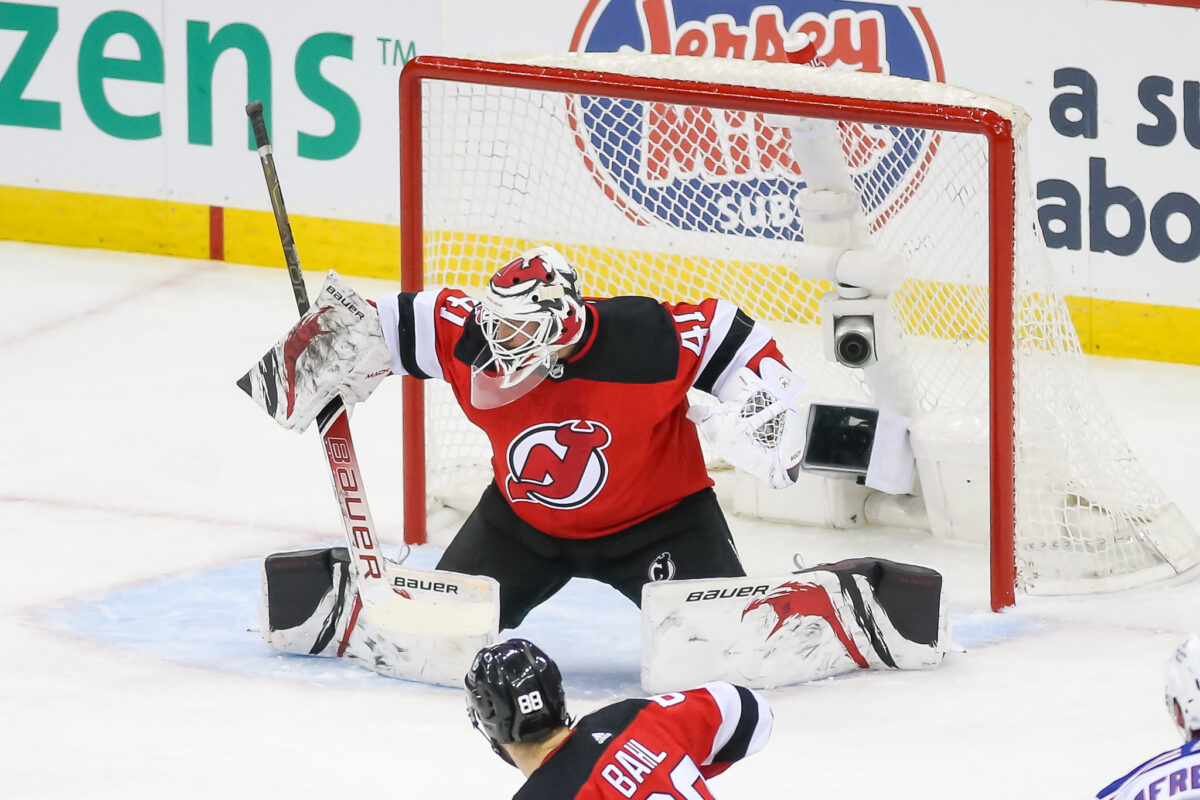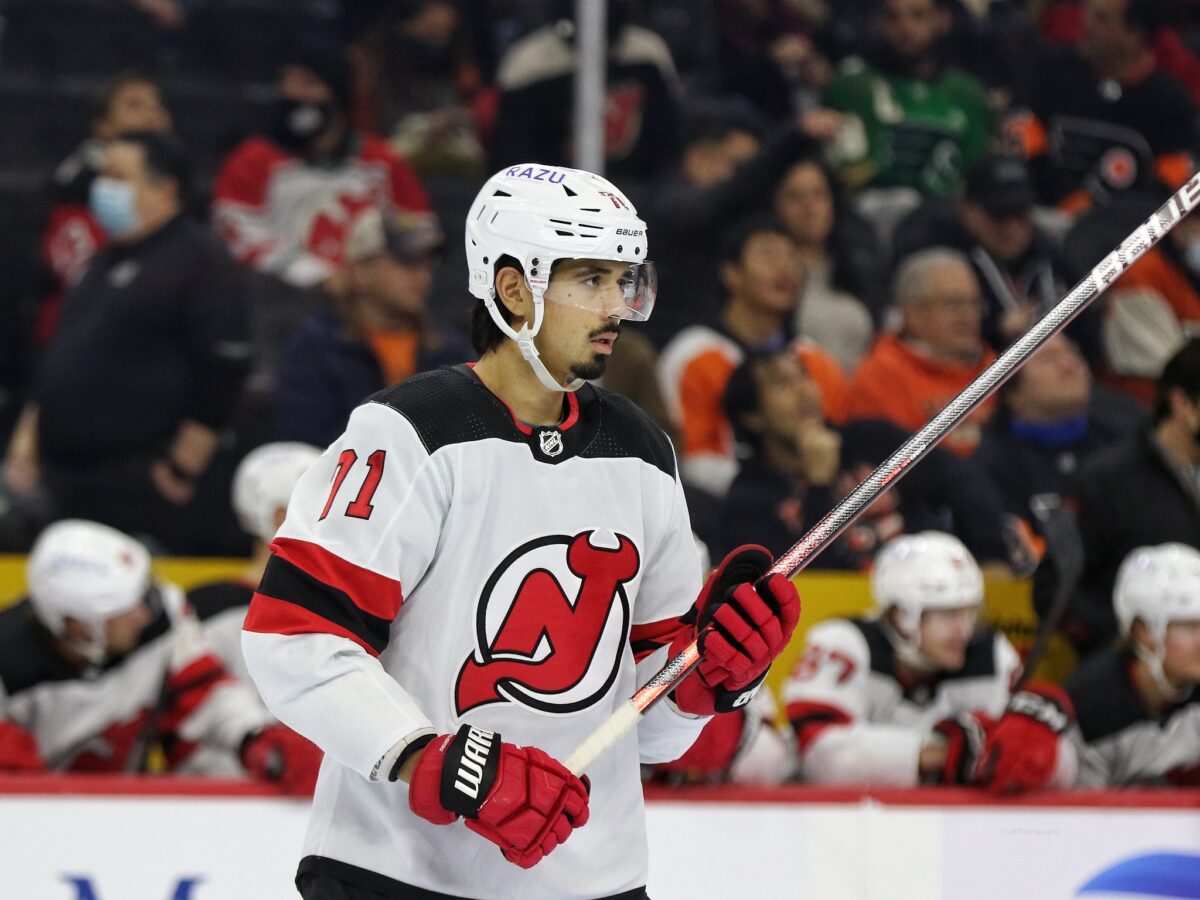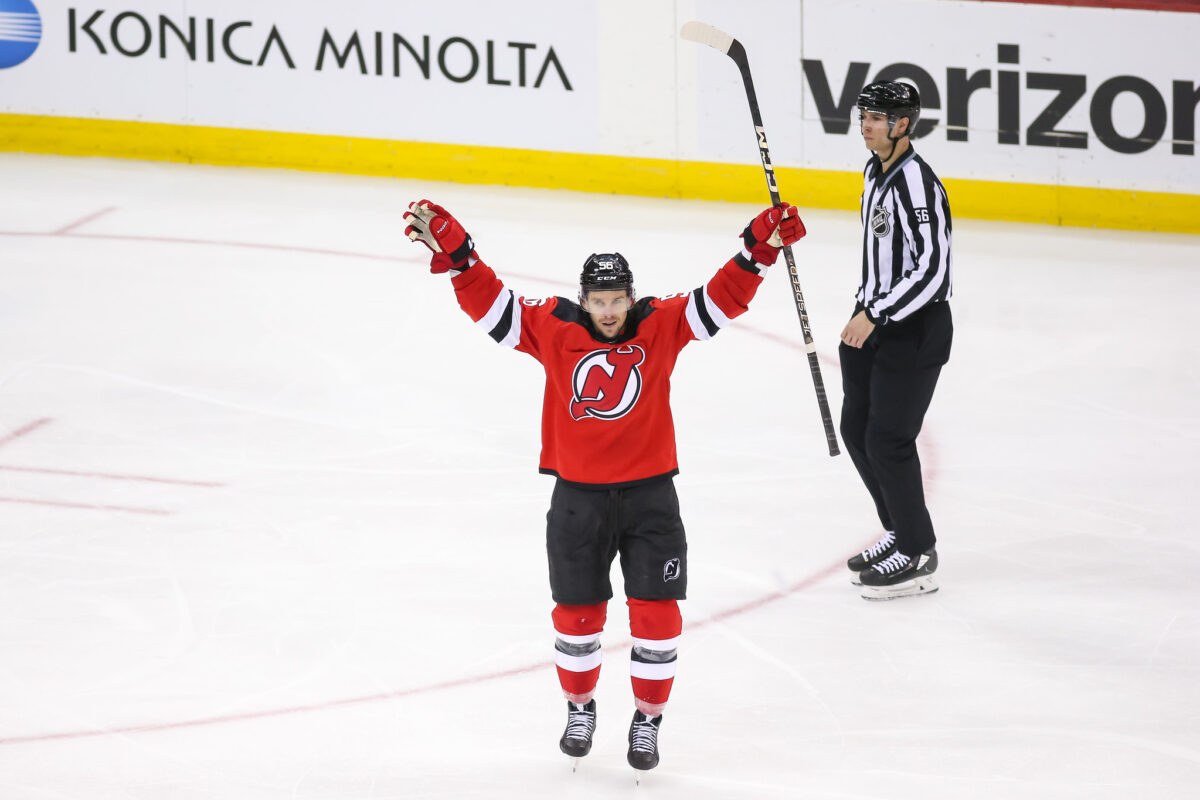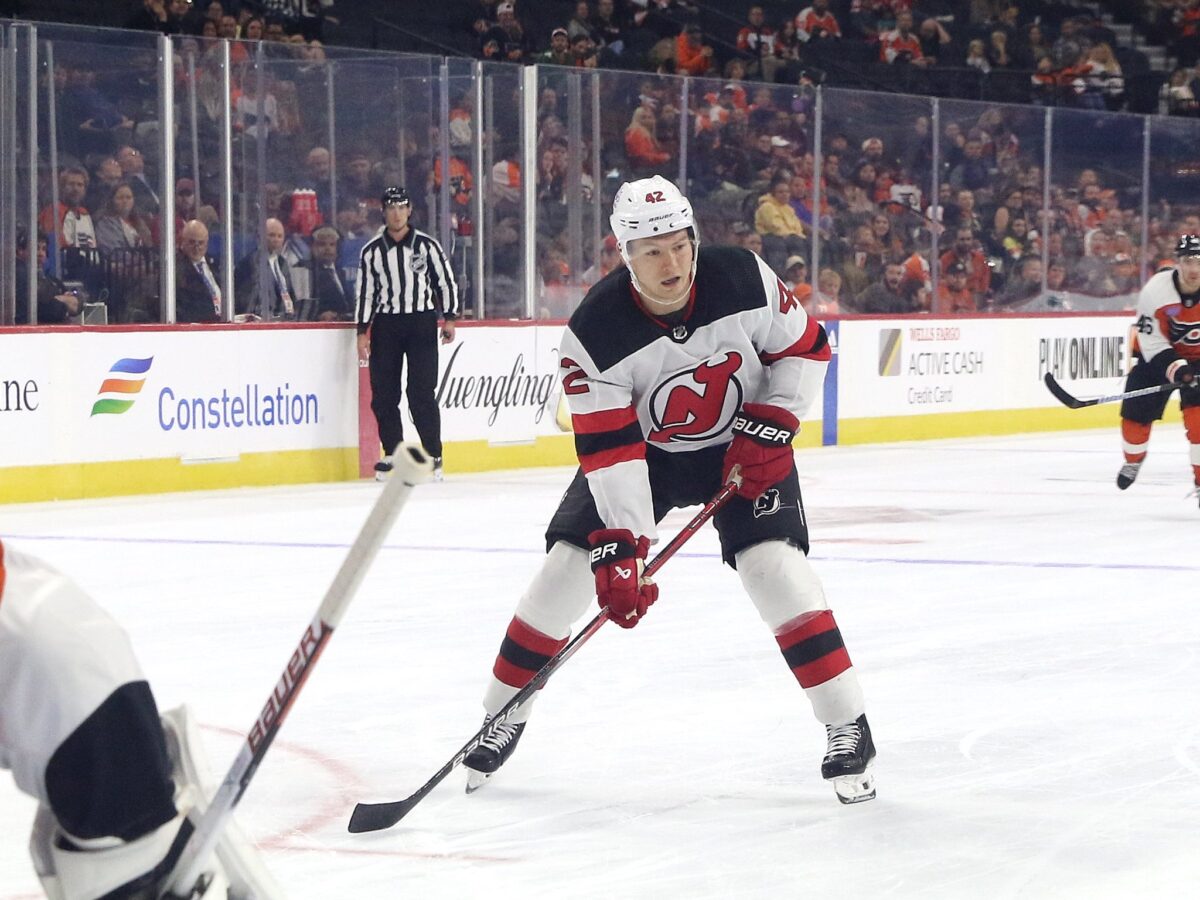After splitting back-to-back games earlier this week, the Devils currently sit at 3-2-1, in second place in the Metropolitan Division, tied with the Philadelphia Flyers and Columbus Blue Jackets and a point clear of the Carolina Hurricanes. It is a comfortable place to be in when the team has played far from its best hockey in the young season. With the glut of teams all within a point of each other, it also means that the team doesn’t have the luxury of waiting too long to find a lineup that works.
Goaltending
All summer, reports swirled of the Devils being in the market for an elite goaltender. Much of the focus centered on star Winnipeg Jets goaltender Connor Hellebuyck who was rumored to want a fresh start with a long-term extension. The trade for Hellebuyck never materialized and he ended up signing that long-term extension to remain with the Jets. The other swirling rumor was a report that the Devils preferred to find a backup goaltender to pair with Vitek Vanecek to allow Akira Schmid a full season in the American Hockey League (AHL) where he could endure the rigors of a full season as a starting goaltender. With the team tight to the salary cap and the goalie market lacking, they opted to run back the tandem of Vanecek and Schmid and have so far split the games evenly.

Vanecek has been largely as advertised. He is an athletic, if smaller, goaltender who relies on his quickness and positioning. In his three years in the NHL, he has posted slightly above league-average numbers in goals against average (GAA) and save percentage (SV%). After a dismal playoff where he was second in the league in most goals allowed above expected, there was a reasonable concern as to whether he could be a starting goalie for a championship-caliber team. So far this season he has returned to form as a slightly above league-average goalie capable of keeping his team in games and making timely saves, but not a player one would expect to carry a team to the Stanley Cup. His current stats, a 3.10 GAA and .900 SV%, are slightly off from his career averages, but it has been over a minimal sample size.
The real issue has been the play of Schmid. While it has been a small sample, and the team has been abysmal defensively at times, one has to wonder whether he would benefit from a demotion to Utica and steady playing time. The second-year player is 1-0-1 with a 4.07 GAA and a .867 SV%, far from his stellar numbers from last season. If there was a time to get him refocused and ready, that time was during last week’s four days off between games. The team is now in the midst of four games in six days and the time for fine-tuning has diminished.
The positive aspect of sending Schmid to Utica is that he could immediately play and work out his issues. He also is waiver-exempt so the Devils could move him freely between the two teams. With Nico Daws still rehabilitating from hip surgery and Eric Kallgren off to a dismal start in the AHL, the most reasonable option would be to recall Keith Kinkaid from the Chicago Wolves. Kinkaid is off to a great start in Chicago having posted a 1.45 GAA and a .941 SV% in his first two games. The Devils signed Kinkaid because they knew in a pinch he could give them competent, veteran goaltending. His play with the Wolves signifies that he is once again healthy and able to contribute. If the Devils are going to make that move, now is the time.
Shaking Up the Defensive Pairs
Head coach Lindy Ruff tinkered with the forward lines and it paid immediate dividends. Unfortunately, the defensive pairs haven’t been as robust. The team has gotten off to a rocky start defensively and it has drawn Ruff’s ire. He was clearly frustrated after the loss to the Washington Capitals saying, “We made an unbelievable effort to play good defensive hockey last year. If we’re going to play like this, we’re going to make it extremely tough on ourselves.” Last season, none of the pairs that played at least 90 minutes together had an xGF% below 50, and this season none of the three pairs used most often are even above 50. Each player has played well in pockets, but of the six it is difficult to identify one player who has been consistent on the defensive end over the first six games. With that in mind, Ruff has two options.
Ruff could either shuffle the pairings or healthy scratch one of his regulars. The injuries to Simon Nemec and Colin Miller disrupted the team’s ability to plug in a defender. Cal Foote is on the roster and is a real possibility to dress for Friday or Sunday but is unlikely to be a long-term solution. The real question becomes who pairs best with whom?
RELATED: Versatile Defense Set for Success
Latest THW Headlines
In many ways, Brendan Smith has replaced Damon Severson as the object of ire of the Devils’ fanbase. The veteran defenseman is derided for his penchant for taking penalties and other perceived indiscretions. The larger issue facing the team is how leaky the top pair has been. Jonas Siegenthaler and Dougie Hamilton are each averaging just under four goals against per 60 minutes. Smith is at 2.29 goals against per 60. The team leaders are Kevin Bahl and John Marino. Not coincidentally, the Bahl-Marino pair has been the best defensive pair at 5v5.

Ruff has options, he could sit Siegenthaler and put Foote in the lineup. Another option would be to play Luke Hughes with Hamilton, as their numbers together have been favorable, but it is difficult to see that pair having enough defensive responsibility for Ruff. For the sake of defending, the best move would be to pair Bahl with Hamilton, allow Siegenthaler to match with Marino to form your shutdown pair, and leave Smith and Hughes alone, as with each game he plays, Hughes is improving in leaps and bounds. Should the team continue to struggle defensively, and Miller be out long-term, general manager Tom Fitzgerald will have to decide between throwing rookie Nemec in the mix or finding a veteran via trade.
Erik Haula
After his exit interview, Erik Haula was very clear, after being a talented journeyman for almost a decade he had found a team he considered family and wanted to remain in New Jersey. The Devils and Haula quickly inked an extension and the forward was set to have a stellar season anchoring a third line that is as talented as any in the league. Then injury struck. The team, and Haula, have refused to disclose both the severity and location of his injury and instead choose to characterize it in terms like, “nagging” and “day to day”, and throughout camp excused his absences as “maintenance days.” It does not appear that his health has improved with the rest and even sitting out a game. The injury may have gotten worse as it is having an impact on his game and starting to impact the team.

This is all speculation since the team is very secretive about its players’ injuries, however watching Haula on the ice and a look at his stats since his return show a player who is not at full strength. He returned to game action against the Montreal Canadiens on Tuesday (Oct. 24) and then suited up again the next night against the Capitals. In both games, he centered the third line surrounded by Dawson Mercer and Alexander Holtz. In the two games combined, Haula’s numbers were well below his standard. At 5v5 with Haula on the ice, the Devils were outshot 16-5, out-chanced 16-14, and outscored 2-0. His Corsi and Fenwick percentages were each below 35 and his xGF% was under 50. If Haula’s injury is going to hamper him to that degree, it may be time to make some adjustments.
Ruff’s options are limited as there is no one-for-one replacement for Haula on the roster as both Tomas Nosek and Nolan Foote are out with injuries. There are really only three options for Ruff, sit Haula until he is healthier and replace him with Mercer and find another third-line winger, replace Haula with Michael McLeod and backfill Chris Tierney into the fourth line, or push Haula to the fourth line, limit his ice time to increase his effectiveness and use either Curtis Lazar or McLeod on the third line. While none of the options are ideal, neither is playing Haula through an injury that is causing his production to deteriorate.
Without knowing the full extent of the injury, it is impossible to determine whether it is something that he will be dealing with all season or if a period of rest will allow him to play freer. Haula is a gamer and would never ask to be out of the lineup; this decision will have to come from Ruff or Fitzgerald, but something needs to be done as allowing him to play hurt could negatively impact the team in both the short and long term.
Swap Third & Fourth Lines
Over the last two games, the production from the third line of Haula, Mercer, and Holtz has been in decline, whether attributable to Mercer’s slow start or Haula’s injury is irrelevant. In that same time, the Devils’ fourth line of McLeod, Lazar, and Bastian has been its second-best line and has earned more ice time. Perhaps the simplest fix for Ruff would be to simply deploy the fourth line as if it were the third line.

Over the course of the last two games, the fourth line has not conceded a goal. Their advanced stats are the best outside of any line that has Jack Hughes. In that time the line boasts a Corsi % of 65 and a Fenwick % of 80. Their xGF% is 60.7 and they have outshot (5-1) and out-chanced (8-3) their opponents. The other key factor is the energy the line brings. It is no secret that when Ruff feels his team needs a burst of energy he sends this group over the boards. The veteran line plays with speed and tenacity and tosses their bodies around the boards with reckless abandon. Their tenacity in all three zones has also reaped rewards for the team as Lazar leads the team in penalties drawn and draws almost six penalties per 60 minutes. When your team has the top power play in the NHL, that is a huge advantage.
And it isn’t just the last two games, over the course of the entire season this unit has played to a 55 xGF%, almost a full 12% higher than the third line, and have combined for 38 hits, the most amongst any forwards. Over the course of the season, their Corsi and Fenwick percentages have hung around 65 and in 24 minutes on the ice, the line has only surrendered one goal. Their xGF% for the season is hovering at nearly 70 and they have outshot and out-chanced their opponents by significant measure as well. This line has earned more ice time and the simplest switch for Ruff is to flip it with the current third line and allow that group to work through its issues while this line provides aggression and results the team lacked against the Capitals.
Changes have to be made, and these four options give the Devils the best chance to duplicate their success both in the short term and throughout the season.
Advanced stats from Natural Stat Trick and Money Puck
